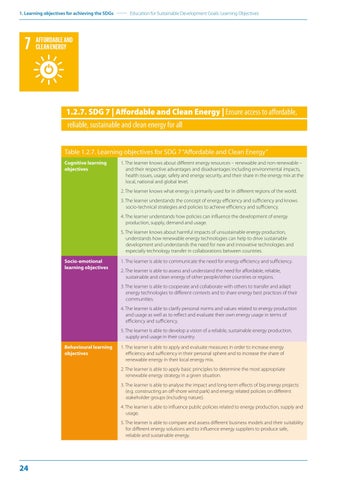1. Learning objectives for achieving the SDGs
Education for Sustainable Development Goals: Learning Objectives
1.2.7. SDG 7 | Affordable and Clean Energy | Ensure access to affordable, reliable, sustainable and clean energy for all Table 1.2.7. Learning objectives for SDG 7 “Affordable and Clean Energy” Cognitive learning objectives
1. The learner knows about different energy resources – renewable and non-renewable – and their respective advantages and disadvantages including environmental impacts, health issues, usage, safety and energy security, and their share in the energy mix at the local, national and global level. 2. The learner knows what energy is primarily used for in different regions of the world. 3. The learner understands the concept of energy efficiency and sufficiency and knows socio-technical strategies and policies to achieve efficiency and sufficiency. 4. The learner understands how policies can influence the development of energy production, supply, demand and usage. 5. The learner knows about harmful impacts of unsustainable energy production, understands how renewable energy technologies can help to drive sustainable development and understands the need for new and innovative technologies and especially technology transfer in collaborations between countries.
Socio-emotional learning objectives
1. The learner is able to communicate the need for energy efficiency and sufficiency. 2. The learner is able to assess and understand the need for affordable, reliable, sustainable and clean energy of other people/other countries or regions. 3. The learner is able to cooperate and collaborate with others to transfer and adapt energy technologies to different contexts and to share energy best practices of their communities. 4. The learner is able to clarify personal norms and values related to energy production and usage as well as to reflect and evaluate their own energy usage in terms of efficiency and sufficiency. 5. The learner is able to develop a vision of a reliable, sustainable energy production, supply and usage in their country.
Behavioural learning objectives
1. The learner is able to apply and evaluate measures in order to increase energy efficiency and sufficiency in their personal sphere and to increase the share of renewable energy in their local energy mix. 2. The learner is able to apply basic principles to determine the most appropriate renewable energy strategy in a given situation. 3. The learner is able to analyse the impact and long-term effects of big energy projects (e.g. constructing an off-shore wind park) and energy related policies on different stakeholder groups (including nature). 4. The learner is able to influence public policies related to energy production, supply and usage. 5. The learner is able to compare and assess different business models and their suitability for different energy solutions and to influence energy suppliers to produce safe, reliable and sustainable energy.
24


